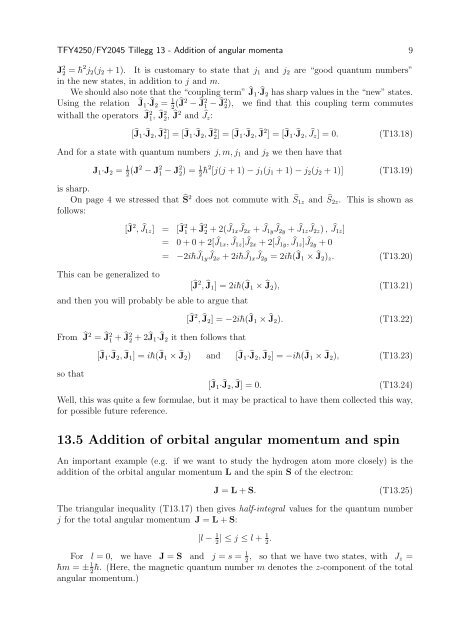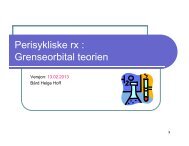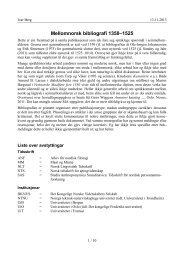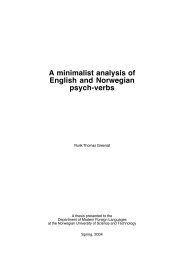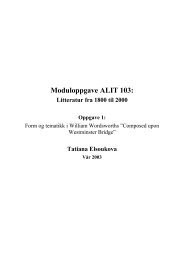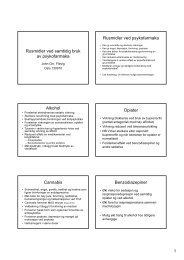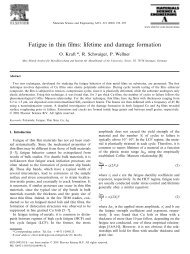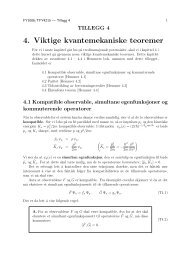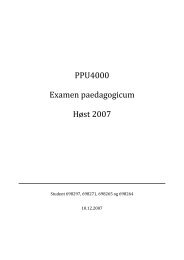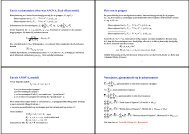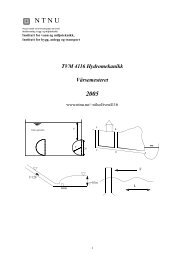Create successful ePaper yourself
Turn your PDF publications into a flip-book with our unique Google optimized e-Paper software.
TFY4250/FY2045 Tillegg <strong>13</strong> - <strong>Addition</strong> <strong>of</strong> <strong>angular</strong> <strong>momenta</strong> 9<br />
J 2 2 = ¯h 2 j 2 (j 2 + 1). It is customary to state that j 1 and j 2 are “good quantum numbers”<br />
in the new states, in addition to j and m.<br />
We should also note that the “coupling term” Ĵ1·Ĵ2 has sharp values in the “new” states.<br />
Using the relation Ĵ1·Ĵ2 = 1 2 (Ĵ2 − Ĵ2 1 − Ĵ2 2), we find that this coupling term commutes<br />
withall the operators Ĵ2 1, Ĵ2 2, Ĵ2 and Ĵz:<br />
[Ĵ1·Ĵ2, Ĵ2 1] = [Ĵ1·Ĵ2, Ĵ2 2] = [Ĵ1·Ĵ2, Ĵ2 ] = [Ĵ1·Ĵ2, Ĵz] = 0.<br />
(T<strong>13</strong>.18)<br />
And for a state with quantum numbers j, m, j 1 and j 2 we then have that<br />
J 1·J 2 = 1 2 (J2 − J 2 1 − J 2 2) = 1 2¯h2 [j(j + 1) − j 1 (j 1 + 1) − j 2 (j 2 + 1)]<br />
(T<strong>13</strong>.19)<br />
is sharp.<br />
On page 4 we stressed that Ŝ2 does not commute with Ŝ1z and Ŝ2z. This is shown as<br />
follows:<br />
This can be generalized to<br />
[Ĵ2 , Ĵ1z] = [Ĵ2 1 + Ĵ2 2 + 2(Ĵ1xĴ2x + Ĵ1yĴ2y + Ĵ1zĴ2z) , Ĵ1z]<br />
= 0 + 0 + 2[Ĵ1x, Ĵ1z]Ĵ2x + 2[Ĵ1y, Ĵ1z]Ĵ2y + 0<br />
and then you will probably be able to argue that<br />
From Ĵ2 = Ĵ2 1 + Ĵ2 2 + 2Ĵ1·Ĵ2 it then follows that<br />
so that<br />
= −2i¯hĴ1yĴ2x + 2i¯hĴ1xĴ2y = 2i¯h(Ĵ1 × Ĵ2) z . (T<strong>13</strong>.20)<br />
[Ĵ2 , Ĵ1] = 2i¯h(Ĵ1 × Ĵ2), (T<strong>13</strong>.21)<br />
[Ĵ2 , Ĵ2] = −2i¯h(Ĵ1 × Ĵ2). (T<strong>13</strong>.22)<br />
[Ĵ1·Ĵ2, Ĵ1] = i¯h(Ĵ1 × Ĵ2) and [Ĵ1·Ĵ2, Ĵ2] = −i¯h(Ĵ1 × Ĵ2), (T<strong>13</strong>.23)<br />
[Ĵ1·Ĵ2, Ĵ] = 0.<br />
(T<strong>13</strong>.24)<br />
Well, this was quite a few formulae, but it may be practical to have them collected this way,<br />
for possible future reference.<br />
<strong>13</strong>.5 <strong>Addition</strong> <strong>of</strong> orbital <strong>angular</strong> momentum and spin<br />
An important example (e.g. if we want to study the hydrogen atom more closely) is the<br />
addition <strong>of</strong> the orbital <strong>angular</strong> momentum L and the spin S <strong>of</strong> the electron:<br />
J = L + S.<br />
(T<strong>13</strong>.25)<br />
The tri<strong>angular</strong> inequality (T<strong>13</strong>.17) then gives half-integral values for the quantum number<br />
j for the total <strong>angular</strong> momentum J = L + S:<br />
|l − 1 2 | ≤ j ≤ l + 1 2 .<br />
For l = 0, we have J = S and j = s = 1, so that we have two states, with J 2 z =<br />
1<br />
¯hm = ± 2¯h. (Here, the magnetic quantum number m denotes the z-component <strong>of</strong> the total<br />
<strong>angular</strong> momentum.)


